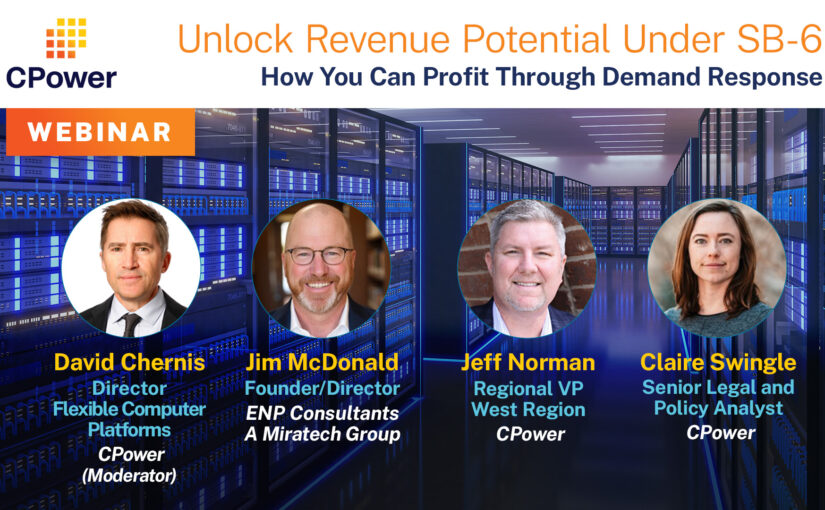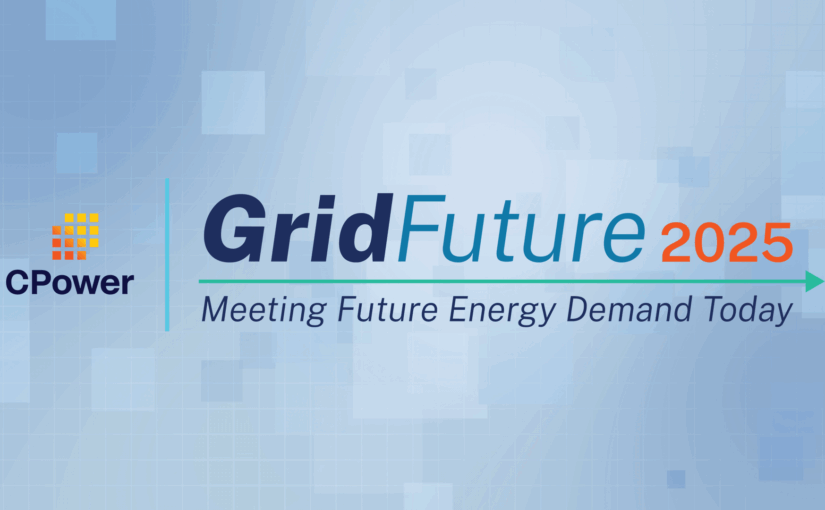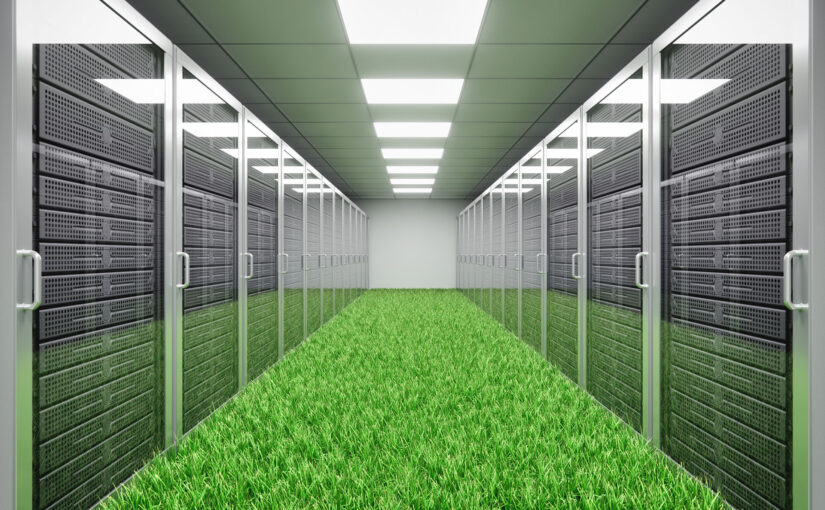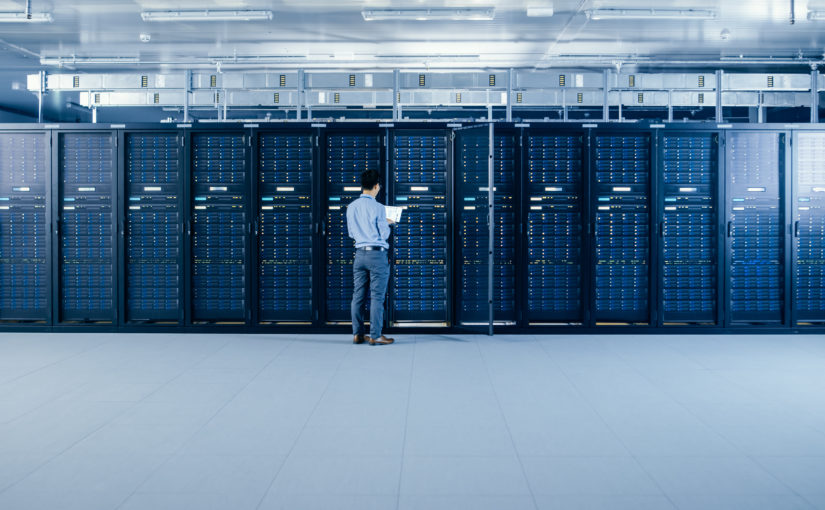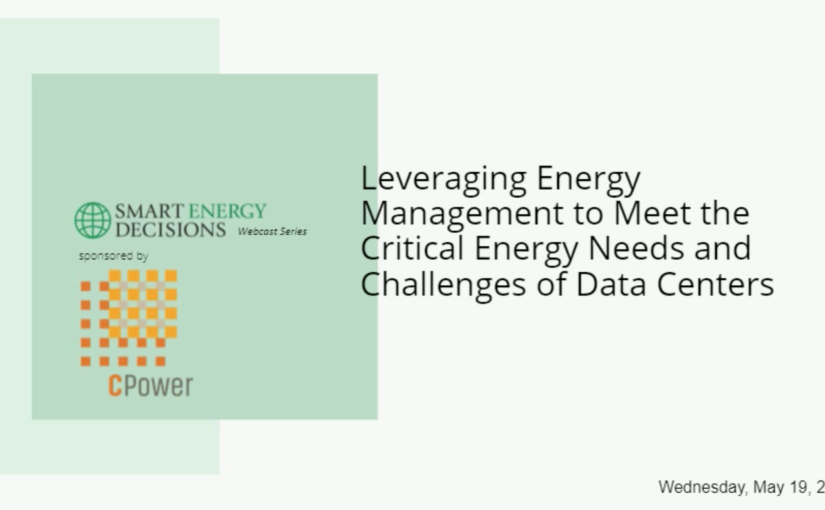Accelerating Speed to Power and Unlocking Innovation with Virtual Power Plants

Flexing data center load through demand response and virtual power plants (VPPs) provides a proven, fast and cost-effective way to power the innovative energy economy.
In an interview with Data Center Dynamics at Yotta 2025, CPower Energy’s David Chernis shared how the latest innovations in energy technology unlock the full potential of flexible energy and drive economic growth powered by artificial intelligence. In dispelling falsehoods about the feasibility of using data centers as critical grid assets, he illustrates the importance of designing data centers for a future in which flexibility speeds connection to power and automation spurs efficiency.
Unlock Revenue Through Energy Flexibility Today, Get Ready for SB6’s Impact on Large Load Participation Tomorrow

Texas Senate Bill 6 (SB-6) is reshaping the energy landscape for large-load customers. With new rules around interconnection, backup generation and load curtailment, SB-6 isn’t just about compliance—it’s about opportunity.
This webinar will show you how to turn regulatory requirements into a competitive advantage by utilizing your flexible energy as a grid asset. Learn how demand response programs can help you reduce costs, unlock new revenue streams and strengthen grid reliability—all while positioning your organization as a leader in energy innovation.
Whether you operate a data center, manufacturing facility or other high-load operation, this session will give you the insights and tools to act now.
AI, Data Centers and the Grid’s “Holy Grail” – Here are 4 Takeaways on Demand Response from GridFuture

While demand response has long played a vital role in energy management, its importance was on full display at CPower’s GridFuture 2025, hosted in Washington, DC, in early August, as stakeholders across the industry noted its importance in tackling unprecedented grid challenges. Paying customers to use less electricity when demand peaks or electricity prices are high is increasingly seen as an efficient means of supplying the power needed to support innovation and spur economic growth.

1. Demand response is a $15B engine for grid and economic resilience.
“This is a pivotal moment in our country’s energy history for demand response. But this isn’t just CPower’s story – it’s a growing chorus across the energy sector,” CPower CEO Michael D. Smith said at GridFuture 2025, the company’s annual thought leadership conference focused on advancements in demand response, distributed energy and virtual power plants.
“It’s because of everyone in this room, and many more out across our ecosystem, that we can drive meaningful outcomes for our customers, for the grid, for our communities and our economy. And that collaboration is essential as we continue to face new challenges as an industry.”
With demand growing faster than new capacity can be built, faster-to-deploy solutions such as demand response bridge the expanding gap between supply and demand. For example, from June 1 to August 1, CPower and its customers across the US provided ~34,000 MWh of load relief during the hottest days of summer, stabilizing the grid and keeping our communities going.
“Demand response acts as the grid’s great economic shock absorber. In times of volatility or disruption, it helps smooth out price spikes while freeing up capital that customers can reinvest elsewhere, including job creation,” Smith said.
Properly utilized, demand response could deliver $15 billion in annual savings nationwide, providing a strategic lever for businesses and the economy. “Great value comes from taking existing assets and leveraging them more effectively and efficiently,” Smith said.

2. The Knowledge Economy demands a smarter, more dynamic grid.
The factor driving the call for more capacity and the biggest economic gains also offers the most immediate and efficient solution: artificial intelligence. More specifically, data centers for AI compute companies, hyperscalers, crypto miners and other large energy users can become grid assets through demand response.
“Data centers are not new, but what is new is the way that AI is pushing the load associated with data centers. AI is changing what load growth looks like and has raised questions about what the next five to 10 years will look like,” said GridFuture 2025 keynote speaker Morgan Scott, vice president, Global Partnerships and Outreach at EPRI.
From transportation to manufacturing to healthcare, AI impacts every industry, requiring exponentially more electricity. “This is creating the knowledge economy, with data centers as knowledge factories. It’s imperative to ensure they have the power they need so that they continue to drive economic growth,” Scott said.
Touching on EPRI’s DCFlex initiative, Scott noted that data centers can leverage flexible energy from energy assets like on-site generation, thermal energy storage, cooling systems or compute workload.
At GridFuture 2025, innovators from Mercury Computing, Emerald AI, Bentaus and Miratech elaborated on unlocking flexibility from data centers. They explored how new technologies enable data centers to adjust power use dynamically, increasing their value to the grid.

3. AI loads are the new frontier of grid flexibility.
“The narrative is starting to change to realizing we can bring stability and resiliency to the grid by working with CPower and others to flex load,” said Bob Davidoff, CEO and Founder, Bentaus.
AI compute load is particularly flexible because power consumption can be adjusted around workloads such as training, fine-tuning and inference. “We need to stop thinking of AI as inherently inflexible and start seeing it for what it is: the Holy Grail of demand-side management,” said Varun Sivaram, CEO, Emerald AI.
“Most end users are focused on results, not where the processing happens. That gives us the power to shift compute in ways that maximize the infrastructure we’ve already built,” he continued.
Some markets connect data centers to the grid sooner for participating in demand response. “Time-to-power is critical to data centers. That is what has allowed the idea of flexible data centers to take root,” said Monty Prekeris, Co-Founder, Mercury Computing.
In some cases, demand response may be required as utilities and grid operators struggle to accommodate large data centers and other large loads.
For example, Texas Senate Bill 6 gives the Electric Reliability Council of Texas (ERCOT) the authority to curtail energy users with electric loads over 75 MW during grid emergencies, such as summer heatwaves when demand peaks or winter storms when power supply can wane.

4. There is no year-round grid reliability without demand response.
Traditionally used to keep the lights on during sweltering summer days, demand response has become a year-round resource with extreme weather creating demand peaks across all seasons. Utilities and grid operators also turn to demand response resources more frequently and on shorter notice to balance the grid amidst rapid shifts in supply or demand due to intermittent generation or other factors.
As demand response has become more accepted and encouraged, it has also become increasingly automated and optimized. And it has expanded beyond curtailed load, encompassing distributed generation, storage, microgrids, smart thermostats, EV chargers and other energy assets. The resulting multitude of complex demand response programs spanning capacity, energy and ancillary services makes simplification paramount.
“We literally have a Saudi Arabia of latent flexibility capability that we have yet to unleash, and we need to do that given the anticipated demand growth in our country. But to leverage it, we need to engage with customers without interrupting their business,” said Ken Schisler, Chief Legal and Regulatory Officer, CPower, in introducing a customer flexibility panel discussion at GridFuture 2025.
Panelists from commercial real estate, transportation and manufacturing shared how they have tailored their load management strategies to their specific industries, as well as best practices for navigating market participation and steps for optimizing their energy assets in grid service programs.
Reflecting on lessons learned from the panel and other GridFuture 2025 presenters, Smith noted the collective impact. “We’ve gained clarity on where our industry is, the vision for what it could become and what actions the industry needs to bridge that gap.”
Glenn Bogarde
As CPower’s Chief Sales and Marketing Officer, Glenn has led the company’s sales team on a nationwide mission to help customers unlock the most value from their flexible energy assets. Glenn has more than 20 years of sales experience in the enterprise software and energy industries.
Decarbonizing Data Centers Gives Grid Flexibility
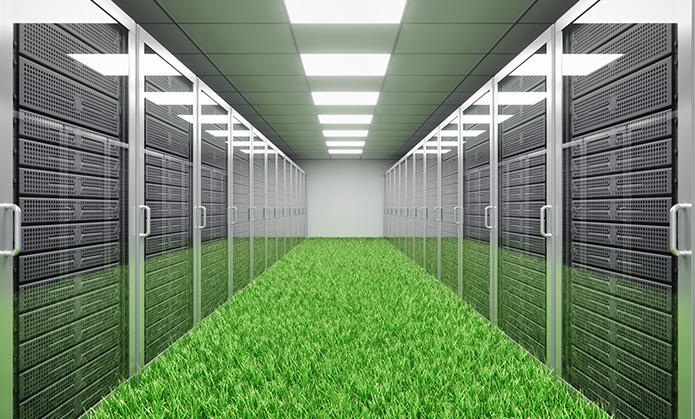
When it comes to energy, data centers are mostly known for how much they consume—but they can give as well as take.
Globally, data centers consumed 220 to 320 TWh of electricity in 2021, or 0.9% to 1.3% of total electricity demand. Within the U.S., they account for about 2% of total electricity use, consuming 10 to 50 times the energy per floor space of a typical commercial office building.
However, rising demand for both data centers and sustainable solutions is causing the industry to shift its approach to tackling both issues. Data centers are driving the renewable energy transition by deploying grid-scale, carbon-free energy.
With companies like Google and Microsoft leading the charge in pledges to reduce their emissions and run data centers 24 hours a day, 7 days a week, 365 days a year on clean energy, we can expect progress by way of industry emissions reductions. Even so, there is far more that can be done for data centers across the board in terms of using energy more responsibly to drive decarbonization.
As data centers look towards a bright future with an eye on growth, efficiency and sustainability, they can join Virtual Power Plants (VPPs) to service their local communities and support the grid by optimizing distributed energy resources (DERs). CPower’s VPP Marketplace, for example, simplifies how data centers communicate, control, and optimize performance of their DERs, rewarding them for reducing their energy while meeting the demands of the grid. This approach will also increase data center sustainability and profitability while increasing community resiliency.
Leveraging Data Centers’ DERs to Achieve Resilience and Reliability
As more front-of-the-meter clean energy resources are integrated with the grid, operators and utilities beg the flexibility of behind-the-meter DERs. Data centers with DERs can complement renewable intermittency to balance supply and demand as well as support the grid in the face of climate change.
Unfortunately, extreme weather events are growing in frequency, threatening a number of the nation’s already ailing electric grids, including across PJM during Winter Storm Elliott in December and throughout the country during a record-breaking summer last year.
There were, however, demonstrations of what’s possible, when energy user DERs helped the grid during those events as well as when Texas data centers contributed curtailment of their power usage from the grid via ERCOT’s demand response program in February 2021, to ensure the grid maintained the necessary frequency to remain online during Winter Storm Uri.
Data centers can leverage demand response programs to optimize idle DERs, including energy efficiency, generator sets, uninterruptible power supplies and solar PV, to maintain reliability during extreme weather or grid stress. In doing so, a data center’s campus can act as a VPP by serving as a flexible resource capable of balancing the grid and ensuring 24/7/365 uptime to a site’s operations as well as its customers’ businesses, in addition to increasing resilience for homes and businesses in the community it serves.
Delivering Community-level Sustainability
Businesses are under increased scrutiny from customers and consumers to act sustainably, investors have recognized long-term gains associated with carbon neutrality and regulators are advancing laws that reflect and address society’s shift towards a clean energy future. The convergence of these factors has created a timely opportunity for data centers to deliver clean and sustainable flexible energy.
For perspective, that lone MW of permanently reduced demand would spare the ozone the GHG equivalent of more than 8.9 million miles driven by an average internal combustion passenger vehicle. By shifting energy usage to a time when the grid mix is cleaner—during the middle of the day when the sun is shining and solar is more prevalent than coal, for example—organizations can lower their overall emissions. When the sun sets, or when DERs go offline, demand-side resources from data centers can help keep the grid balanced and avoid having to fire up costly, dirty peaker plants.
Turning Your Efficient Data Center into a Money Center
While the environmental benefits of energy efficiency projects are substantial for participating data centers, the financial earnings are worth quantifying, too. As an example, when monetized in the PJM capacity market, organizations can achieve permanent load reduction resulting from energy efficiency projects they have completed or will complete in the future.
Increased participation in demand response programs at the ISO and utility levels across the United States offer new tools for grid operators to balance their needs while supporting a cleaner generation mix. Data centers are the ideal candidate to earn revenue through demand response and enable an uninterrupted power supply.
Given the need to be up and always running, data centers utilize N+1 redundancy and are equipped with excess generator capacity which exceeds the center’s total peak demand. Such high-capacity emergency generation systems put data centers in prime position to earn significant revenue with demand response, money that can be used, among other things, to offset a participating organization’s hefty electricity bill, fund equipment or infrastructure upgrades or to pass along to customers in the form of lower rates.
Conclusion
Like the grid, data centers across the world are positioning themselves for a more sustainable tomorrow. The sheer size of the industry alone is large enough to drive meaningful emissions reductions simply by reducing its power demand. As grid operators and technology companies alike work towards a cleaner and more dependable energy future, measuring the impact of demand-side management programs offers a clear path for data centers to further demonstrate their commitment to sustainability.
Most U.S. data centers have energy assets that can help the grid transition to a clean, flexible and dependable future. Call us at 844-276-9371 or visit CPowerEnergy.com/contact to explore how you can use your data center’s energy assets to earn revenue for helping the grid and improving the world’s sustainability.
Nate Soles
As CPower’s Vice President of National Accounts, Nate manages dozens of data center clients and strategies across North America.
Data Centers Have the Grid’s Answer for the Fourth “D”
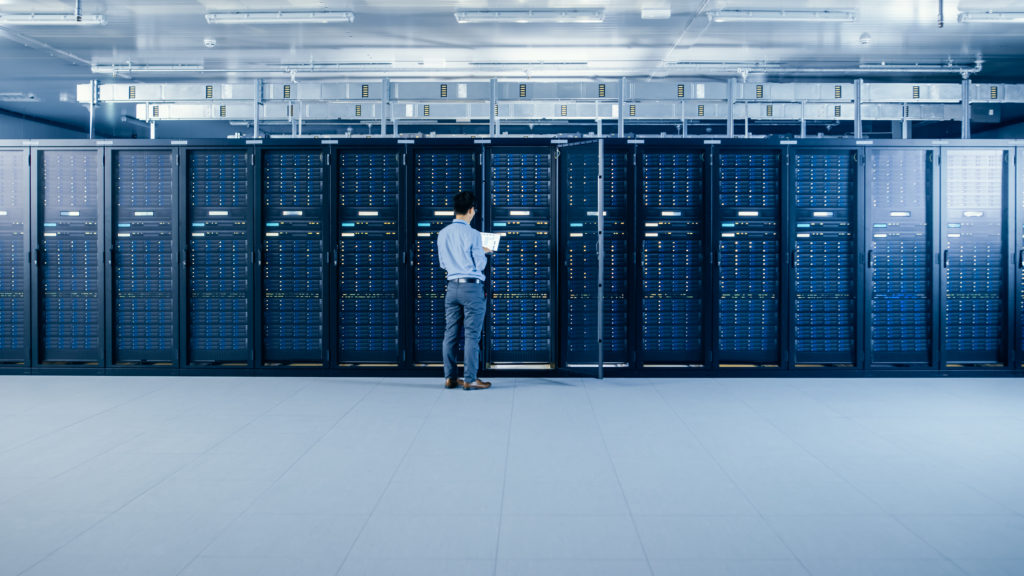
Much has been made in the energy industry during recent years of the “3 Ds,” the macro trends of digitization, decentralization, and decarbonization that have driven the electric grid’s transformation toward a cleaner, more dependable, and efficient future.
The 3 Ds are generally considered to be positive trends rooted in good intentions for the grid and society.
There is, however, a fourth “D” that has been nothing short of a costly troublemaker for the grid since its inception and threatens to undermine every good deed the original 3Ds seek to accomplish.
“Disruption” has been the grid’s ever nemesis since Thomas Edison fired up electricity’s first electric grid in 1882 at Pearl Street Station in lower Manhattan. Like any arch-villain, disruption has a knack of showing up at the most inconvenient of times, particularly when the grid is already vulnerable.
Consider the most disruptive grid events of the last decade. Most were weather-related and resulted in blackouts.
Actually, we don’t have to flip too far in the history book for evidence of weather-related disruption pushing the grid to the brink of total failure. The tragedy this past February in Texas when record winter temperatures forced the ERCOT grid to suffer its first blackouts in a decade is a prime example of disruption’s wicked handiwork.
The California blackouts in August of 2020 that took place during an extreme heatwave in the western US are another example and prove that disruption doesn’t partake in an offseason.
Unfortunately for the grid, disruption is a devil that takes many forms. The COVID pandemic is a prime example.
The lockdowns during 2020 led to electric loads shifting from commercial buildings to residential, which caused grids across the US to work overtime to ensure electric supply and demand remained in balance.
Like death and taxes, disruption may very well be an inevitable fate for the grid. Yet throughout history, fate has had a way of swinging favor back toward the good guys.
Demand response, the practice by which organizations are financially rewarded for shifting load from the grid during times of stress, is a case in point.
We’ve previously written how demand response has been in the US electric grid’s defense arsenal for decades. Today, with the proliferation of distributed energy resources (DERs) adding to that arsenal, demand response has proven to be an even greater thwart to grid disruption than ever before.
Data Centers, with their penchant for owning on-site DERs such as backup generators and energy storage, are in a prime position to participate in demand response and help the grid fend off disruption when the last (or any) of the 4 Ds rears its ugly head.
Across the country, an increasing number of data center organizations are realizing how helping the grid pays immeasurable dividends for their local communities.
During February’s grid collapse in Texas–which tragically resulted in hundreds of citizens losing their lives–data centers proved to be the local heroes.
Data centers participating in demand response programs provided flexible energy resources at the critical times when the ERCOT grid needed them. These resources played an integral role in keeping the grid from a total collapse, which ERCOT has stated was minutes away and would have kept much of the Lone Star State in the dark and freezing for weeks.
For their helping the ERCOT grid, these Texas data centers earned a substantial demand response revenue payment. But it’s their stewardship of community sustainability that should be noted and applauded. Fortunately for data centers, sustainability recognition for demand response participation is starting to garner measurable notice.
Demand response and all forms of demand-side energy management allow the grid to continue its transition from a fossil-fuel-dominated past to a renewable energy future.
Disruption, be it of the foul weather variety or some other adversarial pill will be waiting in lie around every bend of our journey to energy’s future. Within their sophisticated suite of behind-the-meter energy assets, data centers have the antidote to disruption’s poison.
The modern world relies on data centers’ megabytes. The grid and local communities nationwide are counting on data centers megawatts.
To learn more about how data centers can help the grid, reduce their carbon footprint, and improve their local communities’ sustainability, download CPower’s latest ebook: “A New Age of Demand-Side Energy Management.”
Data Center Webinar: Leveraging Energy Management to Meet Critical Energy Needs

This discussion will explore many of the energy-related challenges for data centers and other critical facilities as we look at new and rapidly evolving issues like grid reliability, energy efficiency, renewables, and sustainability within this and other critical industries.
The panel will consist of thought leaders from CPower Energy Management: KC Mares, Director of Data Center Strategies, who brings decades of data center energy management experience, and Nate Soles, VP of National Accounts, who manages dozens of data center clients and strategies across North America.
This is an interactive discussion with a live Q&A from the audience. The session will focus on several key areas and learning objectives:
- Understanding the most important challenges facing data centers today
- How demand-side energy management can and should be a critical strategy for critical facilities
- Understanding the relationship between energy efficiency, reliability, and resilience
- How data centers can play a key role in the grid of the future
- How emergency generation and clean energy can work together for a better future




